| dc.description.abstract | As natural ecosystems become increasingly changed due to habitat alteration, species loss, introduction of non-native species, and climate change, understanding the functional significance of communities to ecosystem function has become imperative. Consequently, recent research has focused on how landscape scale processes influence the distribution of organisms and the influence of organisms on ecosystem function. Freshwater ecosystems are especially sensitive to changes on the landscape because everything that occurs on the land is reflected in the receiving watershed and because of this these ecosystems are subject to declines in native biodiversity that far exceed most terrestrial ecosystems. Approximately half of North American freshwater mussels, a third of crayfishes, a fourth of amphibians, and one fifth of freshwater fishes and gastropods are considered imperiled. This makes research in aquatic freshwater ecosystems essential for understanding the biodiversity of this planet and the linkages between biodiversity and ecosystem function. Linkages between spatial distributions of animals and ecological stoichiometric theory provide a framework for understanding and predicting these linkages. This dissertation shows that examination of spatial patterns in community composition and examination of the role of these communities reveals unknown patterns, interactions, and linkages within stream communities and biogeochemical cycling. Chapter one examined the variables that impact patterns of mussel community composition and showed that stream size and watershed slope are both predictive of community assemblage patterns. The linkages between food webs and nutrient cycles are heterogeneous and often influenced by human activities. Chapter two shows that long-lived mussels integrate agricultural land use in the basin in their tissue as reflected by enriched 15N of their tissue with increasing agriculture. Stoichiometric theory can be extended to ecosystems, such as streams, to predict the role of consumers in food web and nutrient cycles. Chapters three, four, and five show the importance of mussels in influencing nutrient dynamics and their bottom-up impact on stream food webs. Specifically, chapter 3 shows that mussels influence the nutrients that limit primary productivity and mussels shift the system from N-limitation to co-limitation by N and P. This alleviation of strict N-limitation leads to varied algal assemblages in areas with and without mussels with diatoms dominating in areas with mussels and blue-green algae dominating in areas without mussels. This alteration of nutrient limitation and algal assemblages leads to increased heterogeneity within streams. Chapter 4 demonstrates the importance of mussel-derived nitrogen (MDN) to the food web. By enriching mussels with 15N in the lab and then placing them in a stream, I was able to trace the N leaving mussels and entering the stream food web. Chapter 5 investigated the impact of a drought on mussel communities and ecosystem functions (i.e. nutrient cycling and storage). I documented a large loss of mussels between 2010 and 2012 and a consequential decline in nutrient cycling and storage. Furthermore, the loss of specific species (thermally sensitive) led to a change in the N:P excreted by the mussel communities. Stoichiometric theory can be extended to ecosystems, such as streams, to predict the role of consumers in food web and nutrient cycles. Taken together, this dissertation demonstrates that examination of spatial patterns in communities and stoichiometric assumptions improves our understanding of consumer-¬resource dynamics, food webs, the role of consumers in nutrient cycles, and the potential impacts of species loss. | en_US |
